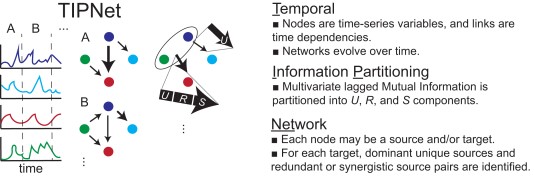In an ecohydrologic system, components of atmospheric, vegetation, and root-soil subsystems participate in forcing and feedback interactions at varying time scales and intensities. The structure of this network of complex interactions varies in terms of connectivity, strength, and time scale due to perturbations or changing conditions such as rainfall, drought, or land use. However, characterization of these interactions is difficult due to multivariate and weak dependencies in the presence of noise, nonlinearities, and limited data. We introduce a framework for Temporal Information Partitioning Networks (TIPNets), in which time-series variables are viewed as nodes, and lagged multivariate mutual information measures are links. These links are partitioned into synergistic, unique, and redundant information components, where synergy is information provided only jointly, unique information is only provided by a single source, and redundancy is overlapping information. We construct TIPNets from 1 min weather station data over several hour time windows. From a comparison of dry, wet, and rainy conditions, we find that information strengths increase when solar radiation and surface moisture are present, and surface moisture and wind variability are redundant and synergistic influences, respectively. Over a growing season, network trends reveal patterns that vary with vegetation and rainfall patterns. The framework presented here enables us to interpret process connectivity in a multivariate context, which can lead to better inference of behavioral shifts due to perturbations in ecohydrologic systems. This work contributes to more holistic characterizations of system behavior, and can benefit a wide variety of studies of complex systems.
http://onlinelibrary.wiley.com/doi/10.1002/2016WR020218/full

